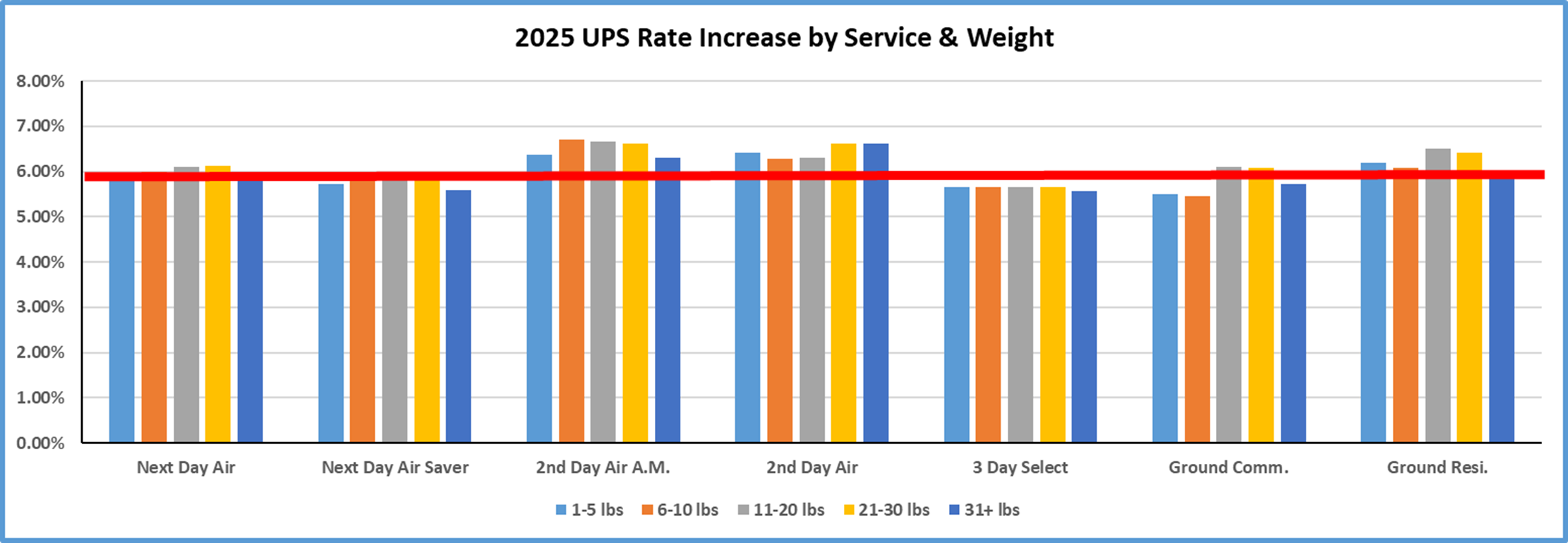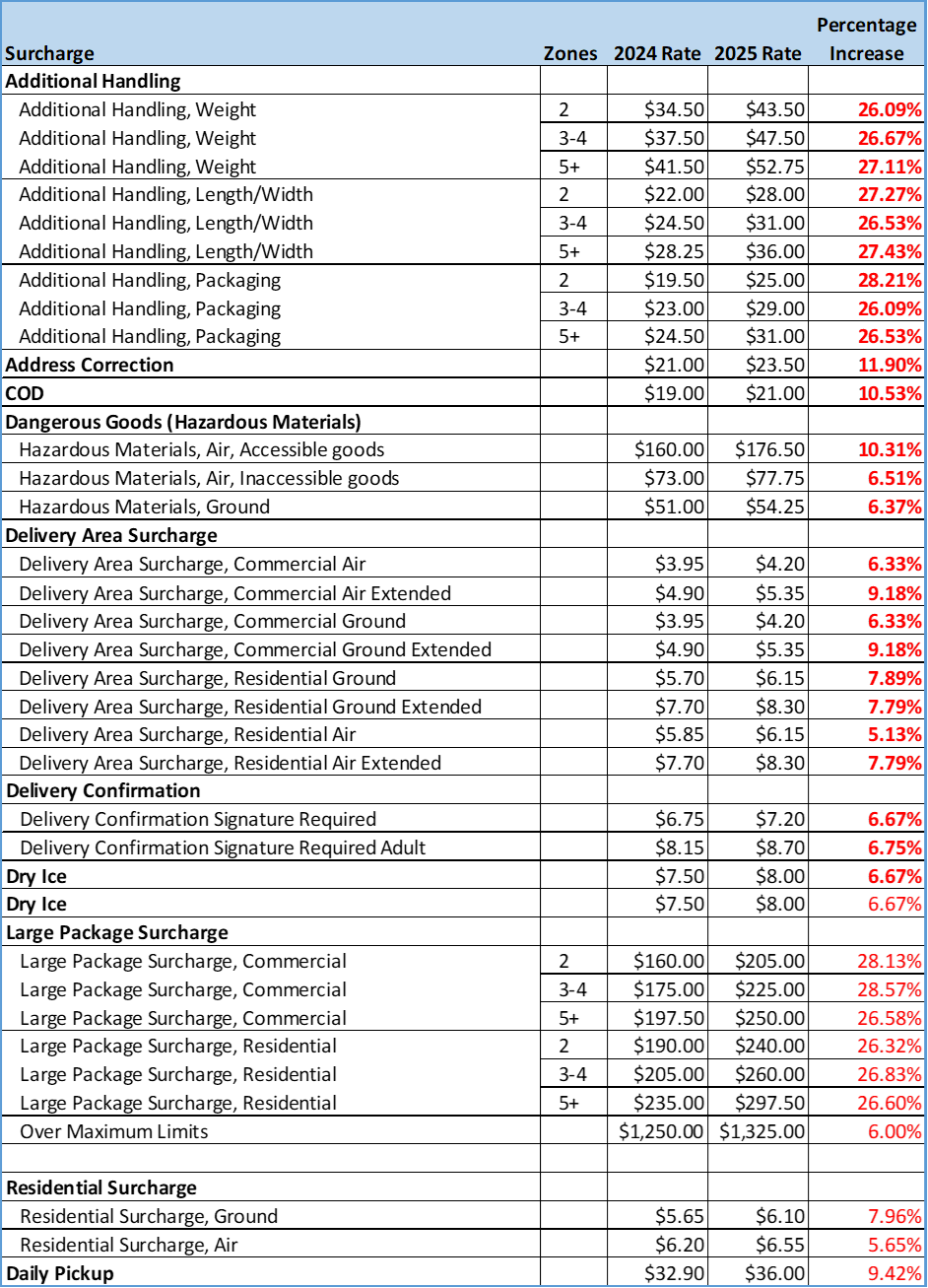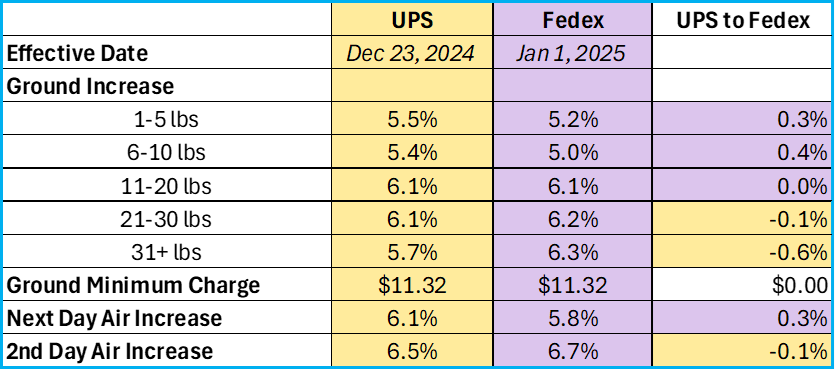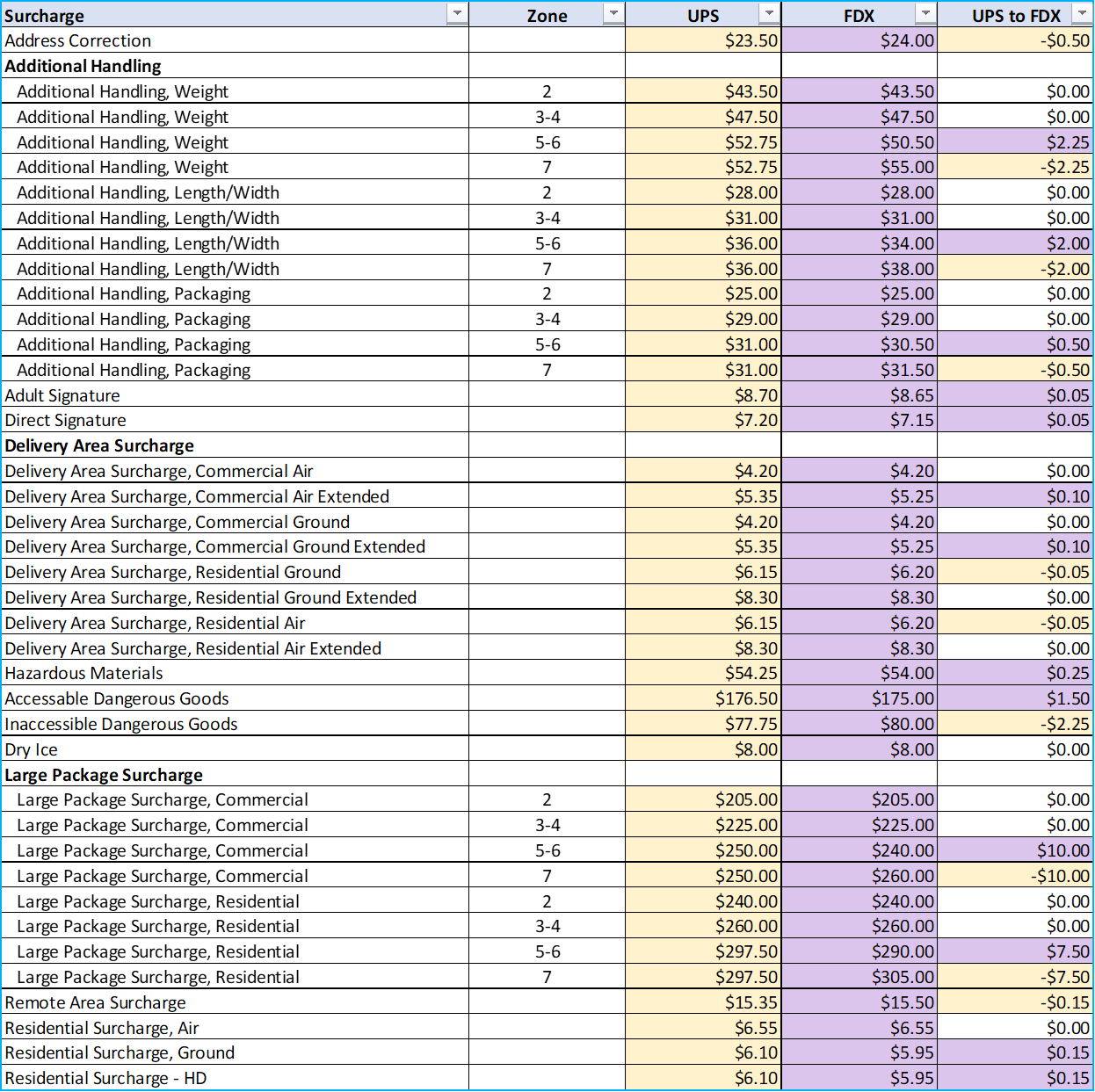UPS announced an average net increase of 5.9% for their 2025 General Rate Increase (GRI), once again matching rival FedEx. While the FedEx increases are effective January 6, 2025, the new UPS rates will go into effect two weeks earlier on December 23, 2024.
As is always the case with carrier General Rate Increases, which is noted with an asterisk at the bottom of the announcement: “The impact of these changes on your shipping costs will vary according to your shipping characteristics and the terms of your UPS agreement.” Translated, very few shippers will realize an increase equivalent to 5.9%; most will be higher. It’s important you understand how base rate and surcharge increases will impact your 2025 UPS spend.
While it’s impossible to analyze every change, below are some important takeaways for all shippers to note and assess:
1. UPS matches FedEx in raising rates by an average of 5.9%
Coming off a very public labor negotiation last year, UPS will continue to face headwinds in 2025 with rising labor costs and the continuation of soft market conditions. UPS admitted losing business during the lengthy negotiation and was negatively impacted by aggressively pursuing low weight, low revenue volume from customers. Raising rates higher than FedEx may have been a good strategy, however the risk of further alienating their existing customers, especially the Small Medium Business customers, was too great.
To no one’s disbelief, UPS matched FedEx with a 5.9% GRI. For nearly a decade, the carriers set their annual increase at 3.9% or 4.9% but broke that trend in 2022 with a 5.9% increase and then again in 2023 with a record-breaking 6.9% increase. In 2024, they decreased their GRI to 5.9% and maintained this increase for the second straight year. One could speculate that the days of 3.9% – 4.9% increases are long gone and that increases of this size will become the norm for the next several years.
It should be noted that UPS has not announced its 2025 Surepost rates at the time of publishing. Shippers using that service should continue to check here for updated rates.
2. Look for unannounced, hidden cost increases
In UPS’s announcement, it was noted that the list of ZIP Codes to which Area Surcharges apply will change, and the list of ZIP Codes aligned to certain zones will change. Most shippers will not have the immediate ability to analyze these zip code changes, which has the potential to be a sneaky way for UPS to increase yield. For example, if the number of ZIP codes hitting Area Surcharge increases overall, shippers will see rates increasing. It will be interesting to see how much the net population is affected by these DAS ZIP Code changes. Likewise, if the number of ZIP codes aligned to Zones 2 and 3 shrinks, turning those shipments into higher zone shipments, shippers will again unknowingly see rates increase.
3. Rate increases are similar across most weight breaks, but longer zone shippers will see higher increases
As illustrated by the following charts, all services will see rate increases across all weight breaks with increases at or above the announced average net increase of 5.9%.
As you can see in Chart One below, 2nd Day Air and Ground Residential shippers will see the largest increases across all weight breaks. Meanwhile, lighter weight Ground Commercial shippers will see the slowest rise in rates next year.
As you can see below, like 2024 UPS has kept the shorter Zones (2-4) more in line with the announced average increase of 5.9%, likely because of the ever-increasing popularity of regional carriers. Also, for the second year in a row 2nd Day Air Zones 5-8 are taking a significant rate increase above 7%. This could be in response to FedEx’s One Rate service which put significant downward pressure on UPS 2nd Day Air revenue and profits.
4. Can’t forget the effect of Minimum Charges
For shippers with existing discounts, the minimum charge, or floor price, go hand in hand with the rate increase. The floor price gives additional protection to UPS from any discounts they have already conceded. For example, say you have a 100% discount but negotiated no minimum discount. You will pay the greater of the Net Shipping Charge or the Minimum Shipping Charge. In this example, you will pay the minimum charge of $11.32 for a ground shipment in 2025 verse $10.70 in 2024: 5.79% higher. Yearly minimum charge increases can have a dramatic impact on your shipping costs.
Interestingly, UPS did not raise their minimum charges above the announced 5.9% increase, breaking their long-standing strategy of capitalizing on significant revenue growth through minimum charge increases. Again, this is most likely to remain competitive with alternative carriers in the market.
5. Almost all common surcharges will increase significantly more than the 5.9% GRI
Don’t get fooled by the headlines! Very few shippers will realize an increase equivalent to 5.9%; most will be higher. If you are not careful, you can blow your parcel budgets with this thinking because the annual GRI announcement does not limit surcharges to the 5.9% rate increase. Again, this year, the most common surcharges will increase significantly higher than 5.9% (See Table Two below) and, depending on your specific profile, may be extremely detrimental to your parcel pricing. Considering surcharges make up between 20% and 40% of a shipper’s annual spend, it’s critical you understand the impact of these increases.
Shippers of large packages will be severely impacted with the 2025 increase. Additional Handling and Large Package Surcharges are increasing over 26.5% on average and in addition, UPS announced new methods for determining Large Package Surcharge and Additional Handling Charge.
While the exact details have not been released, Large Package Surcharge will now be determined using a revised calculation based either on length, weight or cubic volume of shipments. Currently a package is considered a “Large Package” when its length (longest side of the package) plus girth [(2 x width) + (2 x height)] combined exceeds 130 inches or its length exceeds 96 inches. This change is very similar to how UPS currently determines their Additional Handling Charge by either Weight, Length or Girth.
Additional Handling Charge: Length plus girth definition will be replaced by a cubic volume definition to determine applicability. In addition, a minimum billable weight of 40 lbs. has been introduced for packages that qualify for Additional Handling: Length plus girth (dimensions). The exact details have not been released.
UPS also announced the addition of a new surcharge for customers who want to pay their invoices by credit card. This new surcharge will go into effect October 26, 2024 and will equal 2% of the total amount paid via credit card. This new surcharge will effectively negate 2% of any savings you have negotiated with UPS if paying by credit card.
UPS often calls surcharges “levers” that can be used to drive revenue to meet investors’ expectations. Remember, though, as these charges increase dramatically year over year, UPS is opening the door for you to initiate negotiations to mitigate these increases.
6. How does UPS’s GRI announcement compare to FedEx?
As has been the case over the past decade or so, the oligopolistic nature of both UPS and FedEx pricing will continue into 2025. As you can see in the charts below, the differences between the two carriers’ most common services and surcharges vary slightly with FedEx having a slight advantage over UPS in the lighter weight Ground packages and the Residential surcharge. However, one thing to remember is UPS implemented a 40 lbs minimum billable weight for Additional Handling which is a significant price advantage for FedEx if they are willing to accept a larger influx of those shipments in their network.
Comparison of base pricing:
Comparison of surcharge pricing:
What can shippers do?
- Know your data and your specific shipping profile. That is the only way to fully analyze how these increases will impact you.
- Engage multiple carriers. Regional carriers are becoming increasingly viable for almost all shippers and often offer extremely competitive rates. It’s been a year since OnTrac and Lasership merged offering coverage to over 70% of the population. GLS, and others, continue their expansion, while the USPS offers many competitive programs that can fit most shippers’ needs.
- Negotiate! With large increases and the introduction of new charges, the carriers are opening the door for you to lobby them for relief.
In summary, while UPS’s announced an average net GRI of 5.9%, shippers should still anticipate a double-digit price increase after factoring in all surcharge increases. Now more than ever, it is time for you to reach out to your carrier to discuss mitigation tactics. The key is to make sure you have a complete understanding of the impact of annual increases. Whether you have an in-house expert or partner with a consultancy, these increases can’t be ignored. Your budget is at stake, and you owe your organization the chance to have an informed negotiation with your carrier.
Interested in a complimentary UPS GRI Impact Analysis? Contact us here.






